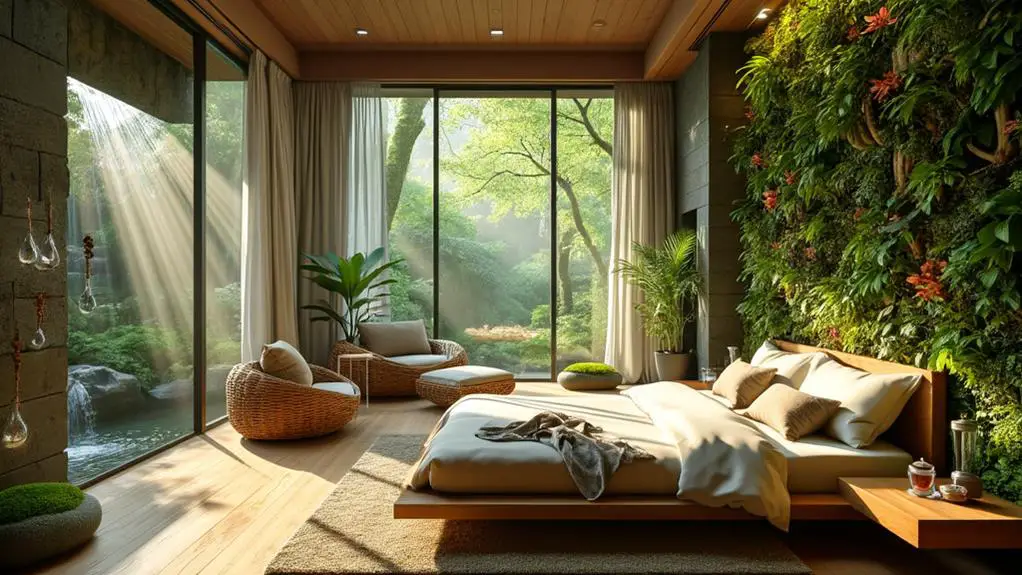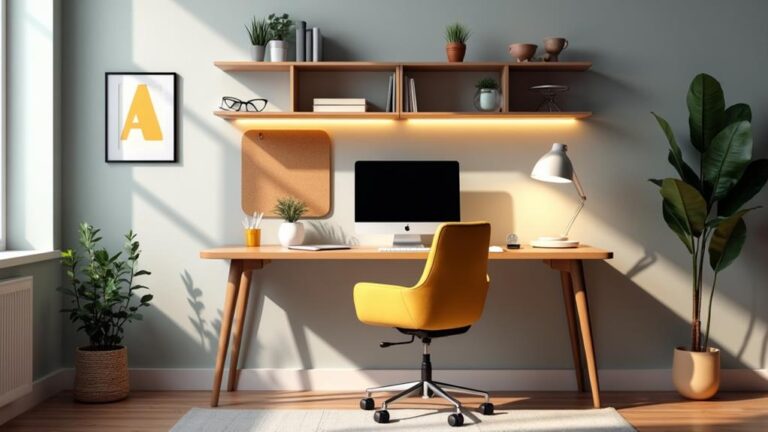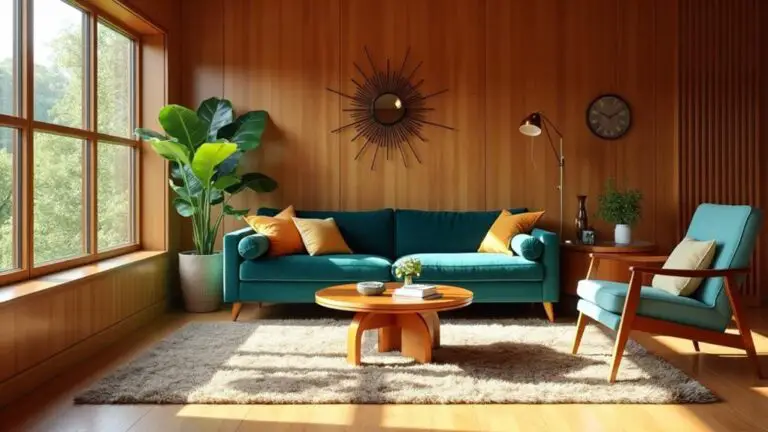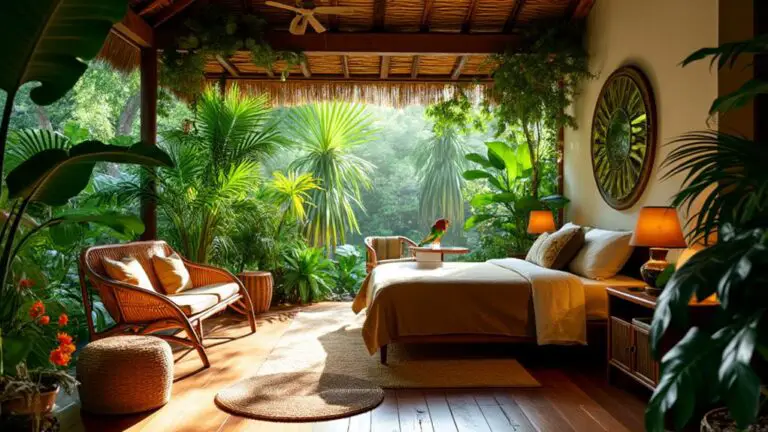Biophilic Bliss: Nature-Integrated Room Designs
I've embraced biophilic design to create nature-integrated rooms that transform living spaces into serene, stress-reducing havens. By incorporating organic materials like wood and stone, maximizing natural light, and adding indoor plants and water features, I've crafted environments that boost well-being and creativity. I've focused on earthy color palettes and textures inspired by nature to enhance the connection with the outdoors. These design choices not only improve air quality and reduce energy costs but also foster a sense of tranquility and mindfulness in daily life. If you're curious about the specific techniques and trends in biophilic design, there's much more to explore.
What To Know
- Biophilic design incorporates natural elements, organic materials, and earthy tones to create harmonious living spaces.
- Maximizing natural light through strategic window placement enhances well-being and reduces energy costs.
- Indoor plants and green walls improve air quality, boost mood, and create tranquil environments.
- Water features serve as focal points, promoting relaxation and improving overall aesthetics.
- Nature-integrated room designs foster a connection to the natural world, enhancing mental health and productivity.
Understanding Biophilic Design Principles

Many people have heard of biophilic design, but few truly understand its core principles. As I've explored this nature-inspired approach, I've come to appreciate its emphasis on our innate connection with nature.
Biophilic design isn't just about adding a few plants to a room; it's an all-encompassing strategy for incorporating natural elements into our built environments.
I've learned that it involves maximizing natural light, using organic materials like wood and stone, and strategically placing indoor plants to improve air quality.
The goal is to create a harmonious space that bridges the gap between indoor comfort and the beauty of the outdoors. By embracing these principles, I've seen how spaces can become more than just functional – they transform into serene, stress-reducing environments that foster creativity and well-being.
Elements of Nature-Integrated Spaces
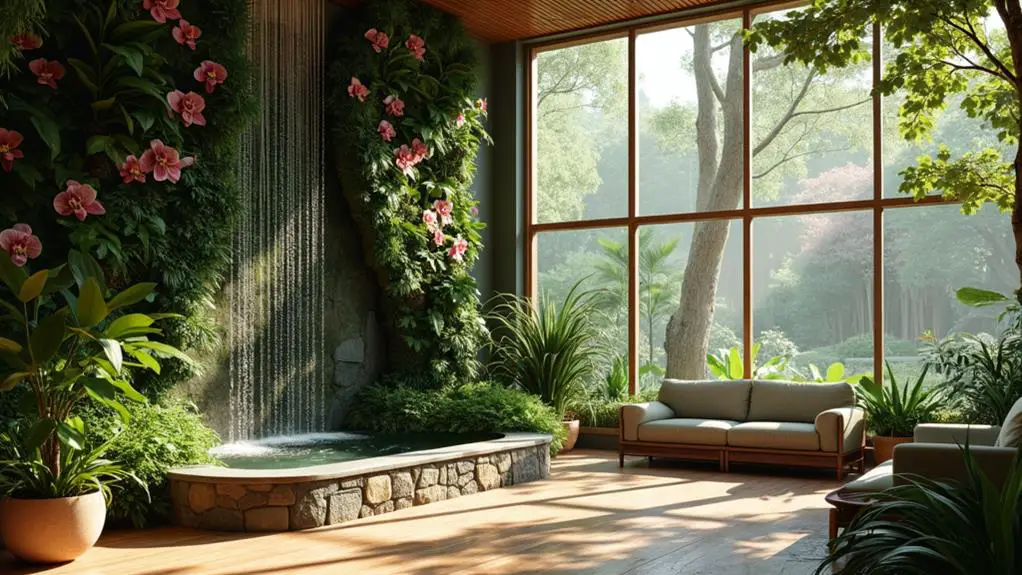
I'm excited to explore the key elements that make nature-integrated spaces so inviting.
Let's start by looking at the use of organic materials and textures, which create a warm and harmonious atmosphere reminiscent of natural environments.
We'll also examine how light and water features play essential roles in these designs, enhancing the overall sensory experience and connection to nature.
Organic Materials and Textures
Organic materials and textures form the foundation of nature-integrated spaces, bringing the outdoors inside through carefully selected elements.
I've found that incorporating wood, stone, and bamboo enhances authenticity and fosters a connection to nature. These materials reflect natural landscapes and textures, creating a multisensory experience that promotes relaxation.
I love using earthy tones derived from nature, like muted greens, browns, and blues, to create a calming atmosphere.
Stone surfaces and wood grains add depth and visual interest, while patterns inspired by nature, such as leaf motifs and flowing lines, can be integrated into furniture and decor.
By utilizing sustainable materials, I'm not only supporting eco-friendly practices but also improving indoor air quality.
The result is a harmonious living space that celebrates the beauty of nature and promotes well-being.
Light and Water Features
Building on the foundation of organic materials and textures, light and water features play a pivotal role in creating nature-integrated spaces. I've found that incorporating these elements strategically placed throughout a room can greatly enhance the biophilic experience. By maximizing natural light through floor-to-ceiling windows and skylights, I'm able to foster a strong connection with the outdoors. I've also noticed that water features contribute notably to a calming atmosphere, mimicking nature's soothing sounds.
| Element | Benefits |
|---|---|
| Natural Light | Enhances brightness, reduces stress |
| Water Features | Creates soothing ambiance, promotes relaxation |
| Light-Filtering Materials | Diffuses light, reduces glare |
| Reflective Surfaces | Amplifies light, opens up spaces |
| Combined Effects | Improves mental health, fosters well-being |
When creating spaces that prioritize these elements, I've observed improved mental health outcomes and a more harmonious living environment.
Maximizing Natural Light
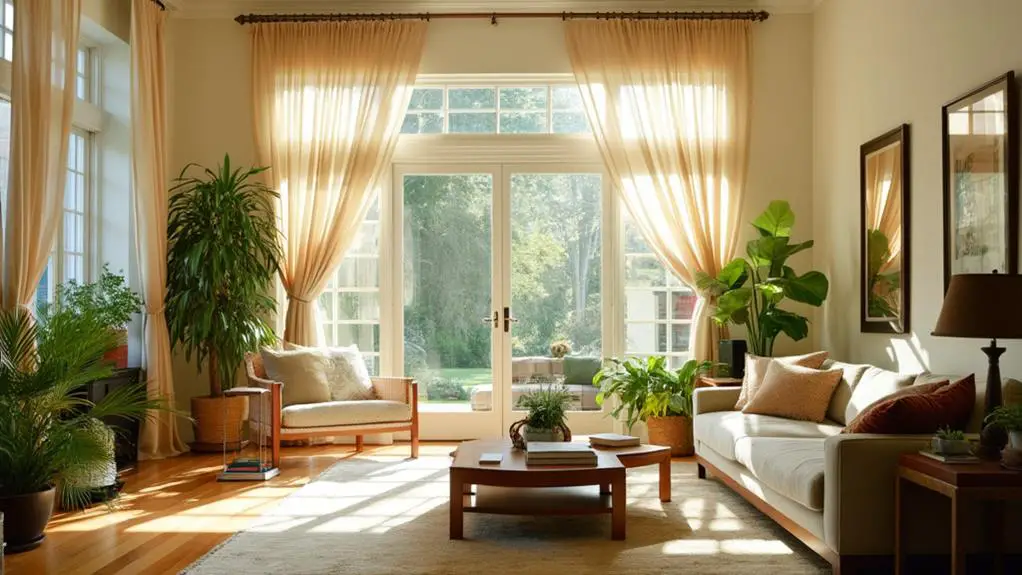
I've found that strategic window placement is essential for maximizing natural light in nature-integrated room designs.
By carefully positioning large windows and skylights, I can flood spaces with sunlight, reducing the need for artificial lighting and lowering energy costs.
I also consider light-filtering materials, like sheer curtains or specialized window films, to create a softer, more inviting atmosphere while still harnessing the benefits of daylight.
Strategic Window Placement
Light is the lifeblood of any interior space, and strategic window placement is key to harnessing its power.
I've found that incorporating floor-to-ceiling windows and skylights can enhance natural light exposure by up to 40%, dramatically brightening interiors.
In the Southern Hemisphere, I prefer north-facing windows to maximize sunlight throughout the day, providing steady illumination without harsh glare.
I often use light-filtering materials in window coverings to create a softer, more inviting atmosphere.
By optimizing window orientation, I can reduce energy costs by up to 30% through passive solar heating.
Large windows also foster a visual connection with nature, promoting emotional well-being and reducing stress.
I've learned that strategic window placement isn't just about aesthetics; it's a powerful tool for creating healthier, more efficient living spaces that seamlessly blend the indoors with the natural world.
Light-Filtering Material Selection
When selecting light-filtering materials, I prioritize maximizing natural light while maintaining concealment and comfort. I've found that sheer curtains and translucent window films create an inviting atmosphere, boosting daylight exposure by up to 50%. This increase positively affects mood and energy levels.
To enhance spaciousness and create a brighter environment, I incorporate reflective surfaces like mirrors alongside light-filtering materials. I also layer fabrics with heavier drapes for flexible light control throughout the day.
Here's a quick comparison of light-filtering options:
| Material | Light Control | Concealment | Ambiance |
|---|---|---|---|
| Sheer Curtains | Moderate | Low | Soft |
| Frosted Glass | High | High | Diffused |
| Translucent Films | Moderate | Moderate | Even |
| Light-Diffusing Shades | Adjustable | Adjustable | Scattered |
Indoor Plants and Green Walls

Embracing the power of nature indoors, indoor plants and green walls have become essential elements in modern nature-integrated room designs.
I've discovered that incorporating these green elements can greatly improve air quality by removing toxins and increasing humidity. The strategic placing of indoor plants, from succulents to ferns, creates visually appealing spaces while contributing to a healthier living environment.
I'm particularly impressed by green walls, which can reduce indoor temperatures by up to 10 degrees Fahrenheit, enhancing comfort and energy efficiency.
The presence of greenery not only boosts mood and productivity but also transforms spaces into tranquil havens by absorbing sound.
Organic Materials and Textures

A multitude of organic materials and textures form the backbone of nature-integrated room designs, elevating spaces beyond mere aesthetics.
I've found that incorporating wood, stone, and bamboo not only enhances visual appeal but also fosters a deep connection to nature. By introducing textured surfaces made from these natural elements, I create a tactile experience that mimics the outdoors.
I'm particularly drawn to earthy finishes and patterns inspired by natural forms, as they establish a calming atmosphere that aligns with biophilic design principles.
When selecting furniture and decor, I prioritize reclaimed or sustainably sourced materials to support eco-friendly practices.
To complete the organic feel, I choose color palettes inspired by nature, such as muted greens and warm browns.
These choices contribute to serene and grounding indoor environments that truly embrace the essence of the natural world.
Water Features in Interior Design
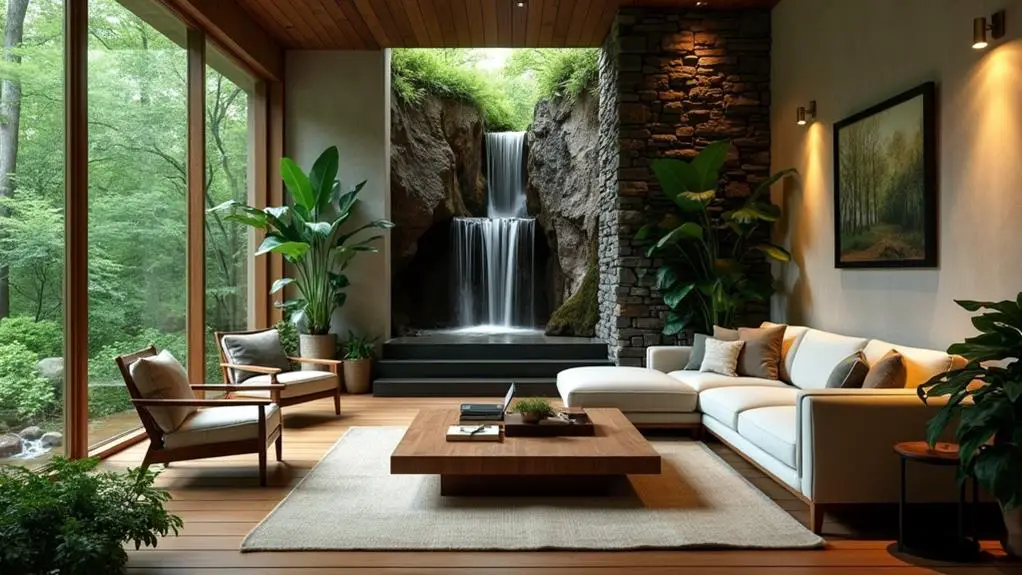
Water features' transformative power in interior design can't be overstated. I've found that incorporating them into spaces creates a calming atmosphere and enhances the overall aesthetic. The soothing sounds and visuals of indoor fountains or small ponds greatly reduce stress levels, promoting relaxation and mindfulness. I've observed how water features can improve air quality by increasing humidity and reducing dust, benefiting our health.
| Benefits | Examples |
|---|---|
| Stress reduction | Indoor fountains |
| Aesthetic appeal | Small ponds |
| Air quality | Wall waterfalls |
| Nature connection | Tabletop features |
Creating a connection to nature through water features is a growing interior design trend. By mimicking natural landscapes, these elements allow us to feel connected to the outdoors even in urban settings. I've found that strategically placing water features near seating areas encourages relaxation and enhances our overall well-being.
Color Palettes Inspired by Nature
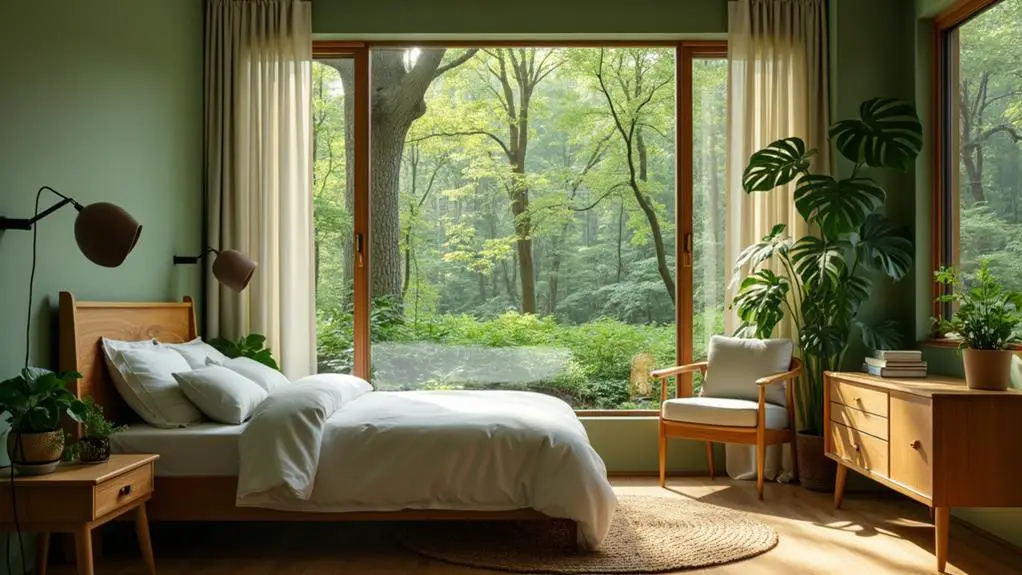
Nature's color palette offers a rich source of inspiration for interior design. I've found that incorporating earthy tones, muted greens, and calming blues into my spaces creates a serene atmosphere that evokes Australia's diverse landscapes.
By using natural hues like terracotta and sandy beiges, I'm able to ground my environment and foster tranquility.
Here's how I integrate nature-inspired colors:
- Choose a cohesive color scheme that mirrors the surrounding environment
- Include shades reflecting seasonal changes for a dynamic aesthetic
- Add textured surfaces with leaf motifs or wave-like designs for visual richness
- Balance warm autumnal colors with fresh spring pastels
This approach not only establishes visual links to the outdoors but also promotes emotional well-being.
I've noticed that these nature-inspired color palettes create a multisensory experience, enhancing relaxation and connection to the natural world.
Conclusion
I've explored the world of biophilic design, and I'm convinced it's the key to creating harmonious living spaces. By bringing nature indoors, we're not just decorating; we're nurturing our well-being. I've seen how natural light uplifts, how plants purify, and how organic materials ground us. I've felt the calming effects of water features and nature-inspired colors. I'm ready to transform my home into a sanctuary where I can thrive, not just survive.

